What Does a Pomegranate Taste Like?
When you buy through our links, The Breslin may earn an affiliate commission. Learn more
If you’re asking, “what does pomegranate taste like?” then you’re probably missing out on a healthy and tasty fruit. Don’t worry; I’ve been there too, so I can totally understand why trying a pomegranate can be a little daunting.

However, don’t let their “exotic” appearance put you off from trying them out. If you want more details about the taste before making the final decision, then this post is exactly what you need.
Keep reading to learn a thing or two about pomegranate tastes, popular types of pomegranate, and when you shouldn’t eat one!
Pomegranate – The Forgotten Superfruit
The pomegranate or Punica granatum is a 16 to 33 ft tall fruit-bearing deciduous shrub of the Lythraceae family.
Pomegranates are widely grown and harvested in India, Central Asia, dry areas of Southeast Asia, the Middle East and Caucasus region, the Mediterranean Basin, and some parts of Africa. In the U.S, they are chiefly cultivated in California and Arizona.
Pomegranate fruit is round in shape and quite similar to navel orange in size (about 2 to 5 inches). It has a hard, reddish outer skin with a spongy, white (sometimes sweet red) interior in which juicy, purple-red “seeds” (technically called arils) can be found.(1)
There are approximately 600 arils in 1 pomegranate fruit. Inside of these corn kernel-sized arils are sweet red, nutritious juice, and a crunchy seed. Although the seeds can be eaten along with the juice, some people choose not to.
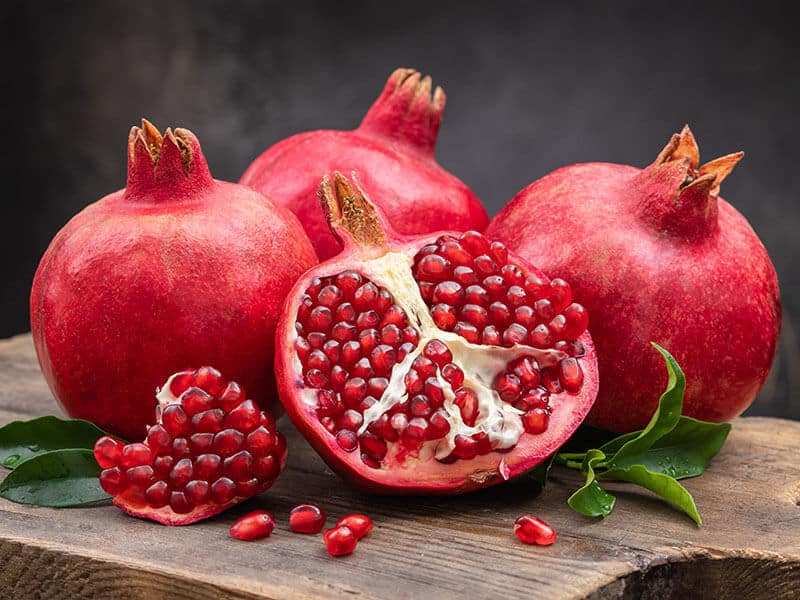
When people talk about pomegranates’ taste, they usually refer to their arils since these are the only edible parts of the fruit. Their peels, though inedible, can be used to make pomegranate extract and powder.
Pomegranate’s history can be traced back to ancient times, thus explaining its appearance in various mythology and beliefs.
For the ancient Egyptians, the pomegranate was the symbol of prosperity and ambition. It also appeared in Greek mythology as the “fruit of the dead” due to its connection to Persephone – the goddess of the underworld.
However, there is nothing “underworldly” about this fruit. In fact, the pomegranate is one of the healthiest fruits that money can buy. In one pomegranate, you can find plenty of essential nutrients such as fiber, protein, vitamin C, vitamin K, folate, and potassium.
In addition, these red fruits contain a large percentage of punicalagin and punicic acid – 2 compounds that are famous for their medicinal properties.
Not only that, but pomegranates are also great at reducing chronic inflammation, which is the main cause of severe illnesses like heart disease, cancer, and Alzheimer’s. (2)
Learn all about pomegranate’s excellent health benefits. You can see this video to know more:
The sad news is, even though pomegranates boast potent nutritional value, most Americans are neglecting or aren’t even aware of the fruit’s existence. Did you know that, on average, an American only eats less than one pomegranate a year? (3)
The General Taste Of Pomegranates
Pomegranates have a slightly sweet and tart taste with a pulpy yet crunchy texture. All in all, the flavor is pretty refreshing and will leave a sweet aftertaste on your tongue. Some people describe pomegranates as big cranberries or giant raspberries.
That said, this is only the general description of pomegranate’s taste. In reality, the flavor of pomegranates will change depending on their ripeness and types. Yes, you read it right; there’s more than one variety of pomegranates (more on this in the next section).
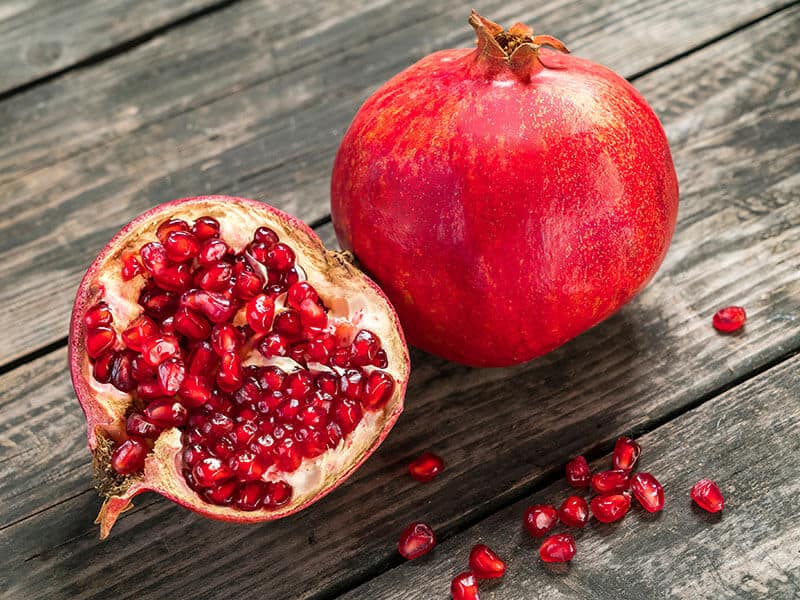
In terms of flavor, ripe pomegranates are comparable to ripe cherries – sweet but can be a little sour. You can also think of ripe pomegranate as a sweet grape “taste-alike”.
However, don’t expect ripe pomegranate to be as sweet as other fruits like sweet apples or ripe grapes. Although the sweetness is clearly there, you’ll see that pomegranates lean more on the sour side.
Unripe pomegranates, on the other hand, are pretty unpleasant to eat since they lack the subtle sweet notes of the ripe ones. The only flavors that you’ll most likely be able to taste are sour and bitter, which can be unbearable for many.
Popular Types Of Pomegranates And Their Taste
As mentioned above, there are many varieties of pomegranate. Each of them has its unique characteristics and taste. Here are some of the more popular ones.
| Pomegranate Types | Outstanding Characteristics |
| Wonderful Pomegranate | Dark red color, typical pomegranate taste |
| Angel Red Pomegranate | Very juicy, sweet, and less sour than other varieties |
| Golden Globe Pomegranate | Golden skin, sweet and juicy, suitable for making drinks |
| Parfianka Pomegranate | Balanced flavor, soft and juicy arils |
| Ambrosia Pomegranate | Large size, classic taste but can be a little tart |
| Pink Satin Pomegranate | Pink skin and arils, taste like fruit punch |
| Sharp Velvet Pomegranate | Dark red skin and arils, sharp taste |
| Eversweet Pomegranate | Very sweet, seedless fruit |
| Desertnyi Pomegranate | Great dessert choice, citrusy taste |
| Gissarskii Rozovyi Pomegranate | Sweet, slightly tart flavor, can taste similar to lemonade |
Wonderful Pomegranate
Wonderful pomegranates make up for a large percentage of pomegranates sold in the States. It ticks all the boxes of a typical pomegranate’s description: dark red in color and tangy with subtle hints of sweetness for taste.
Angel Red Pomegranate
Angel Red is another heavy hitter in the pomegranate market. It bears vivid red skin with bright red arils. Angel Red has a higher juice content than most varieties, thus making it an ideal choice for juicing.
The arils are sweet, a little less sour than Wonderful pomegranate, and soft enough to be eaten fresh. You may find the sweet-sour flavor similar to the taste of raspberry, tart cherry, rhubarb, or red currant.
Golden Globe Pomegranate
The golden skin with traces of red blush is what sets Golden Globe apart from other varieties. In addition, it has pleasantly sweet and juicy arils that are perfect for making juice or fruit punch. Golden Globe pomegranates are mainly grown in cool coastal climate areas.
Parfianka Pomegranate
Parfinaka pomegranate boasts a perfectly balanced sweet and tangy flavor that is often compared to wine. Although its pink arils are a little small, they are very soft and juicy.
Ambrosia Pomegranate
This variety’s most significant selling point is its incredible size, as these pale pink fruits can grow up to three times bigger than their Wonderful cousins.
In terms of flavor, Ambrosia still has that classic sweet and tangy taste but can be a little more tart than Wonderful pomegranates.
Pink Satin Pomegranate
As the name implies, Pink Satin pomegranate comes with pink skin and light pink arils. It has a sweet flavor that bears a strong resemblance to fruit punch.
Sharp Velvet Pomegranate
Sharp Velvet’s crushed velvet red arils are wrapped by a layer of thick, deep red skin, which explains the “velvet” part of its name. What about the “sharp” part? Well, the unique acidic and sharp taste rightfully earns this variety its impressive name.
Eversweet Pomegranate
Eversweet is one of the sweetest pomegranate types (I mean, you can’t really get any sweeter than “eversweet”). It has red skin, practically seedless arils, and clear, non-staining juice.
Desertnyi Pomegranate
Desertnyi can be translated to, you guessed it, dessert, which explains why this pomegranate makes such a perfect dessert choice.
For taste, you can expect a flawless blend of pomegranate’s classic sweet-tart and citruses’ fruity, refreshing flavor. Thanks to the citrusy notes, ripe desertnyi pomegranates can also remind you of orange juice.
Gissarskii Rozovyi Pomegranate
Last on the list is Gissarskii Rozovyi – a large, pinkish in color pomegranate variety with mildly sweet and slightly tart arils. With the right amount of sugar, some people might even mistake its juice for lemonade.
Pomegranate’s Taste In Other Forms
While pomegranates are tasty when eaten fresh, many people prefer to have their pomegranate in other forms like juice or wine. Let’s see how this superfruit fares in these forms.
| Pomegranate Form | Unique Characteristics |
| Pomegranate Juice | Sweet, sour, and fruity taste, very popular |
| Pomegranate Wine | A blend of both sweet and tangy taste, can be highly acidic |
| Pomegranate Molasses | Rich, intense taste, used commonly in Middle Eastern cooking |
| Pomegranate Powder | Made from peel: used for skincare, healthcare Made from juice: used in cooking as a souring agent |
Pomegranate Juice
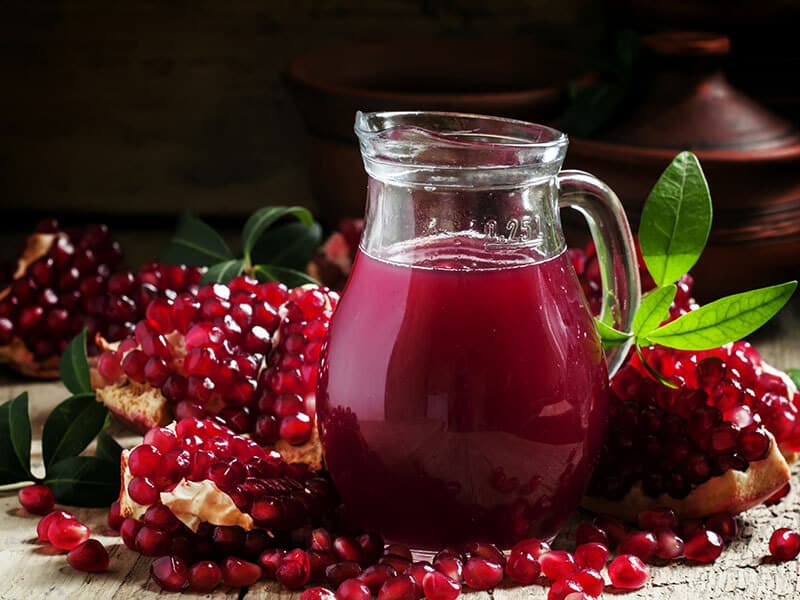
Pomegranate juice has to be one of (if not) the most popular forms of pomegranate. Even people who haven’t eaten a single pomegranate in their life might have drunk its juice.
In theory, pomegranate juice should taste and smell exactly like fresh pomegranates, which are sweet and sour with a fruity aroma. However, due to the pasteurization process and sometimes the extra added sugar, you might find the juice a tiny bit sweeter.
If you want to retain the original taste as much as possible, you can buy fresh pomegranates and juice them at home. It’s fairly simple to do and won’t take you that long!
Making pomegranate juice is actually easy peasy lemon squeezy! You can see this video to know more:
Pomegranate Wine

At first sight, pomegranate wine looks a lot like red wine due to its similarities in color. That said, it is more expensive since many think of pomegranate as an “exotic fruit”.
Pure pomegranate wine’s taste will vary depending on the pomegranate variety that it was made from. Some can be sweet, some tangy, but most of the time, it will be a blend of both.
Due to pomegranate’s high acidic content, its wine naturally has a sour taste that, frankly, can be unpleasant. To reduce the sourness, winemakers often mix it with grape wine to make fruit wine or add sugar to create a semi-sweet taste.
Pomegranate Molasses
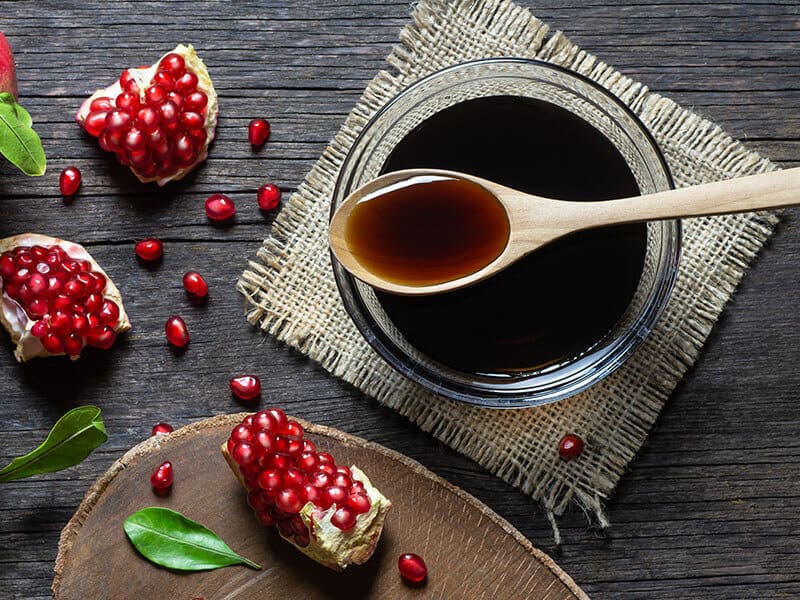
Pomegranate molasses is a syrup made from pomegranate juice. It has a half-sweet, half-sour flavor that is more intense than other forms.
Thanks to its thick consistency and rich taste, a drizzle of pomegranate molasses is more than enough to elevate any dishes that need an extra kick in acidity. You can commonly find this syrup in Middle Eastern recipes.
Pomegranate Powder
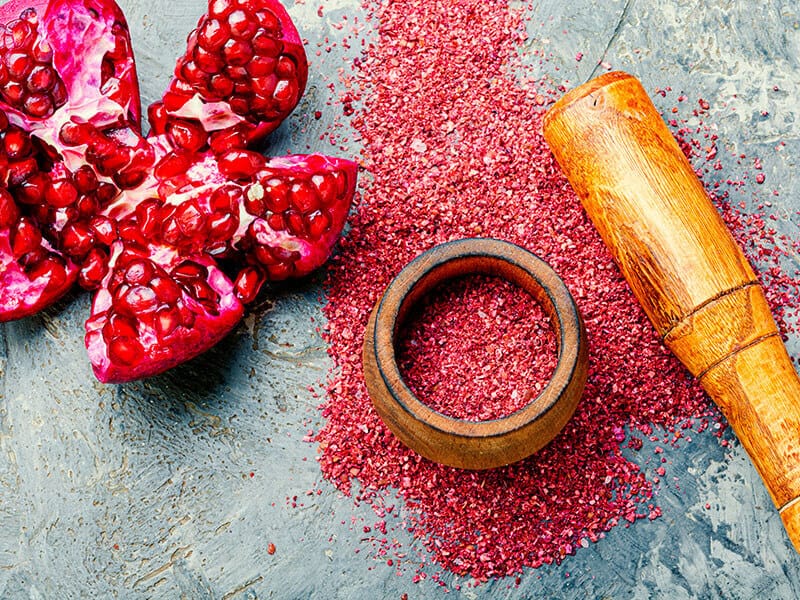
You can often find 2 types of pomegranate powder on the market.
The first one is made from dried pomegranate peel and is used to treat acne, prevent hair loss, and as a cure for sore throat.
The other type is made from the juice of fresh pomegranates and is utilized in cooking as a potent souring agent. Its tangy and sweet taste fits really well in curry, salad, smoothies, chutney, chicken, lamb, or guacamole recipes.
Your Pomegranate Shouldn’t Taste Like This
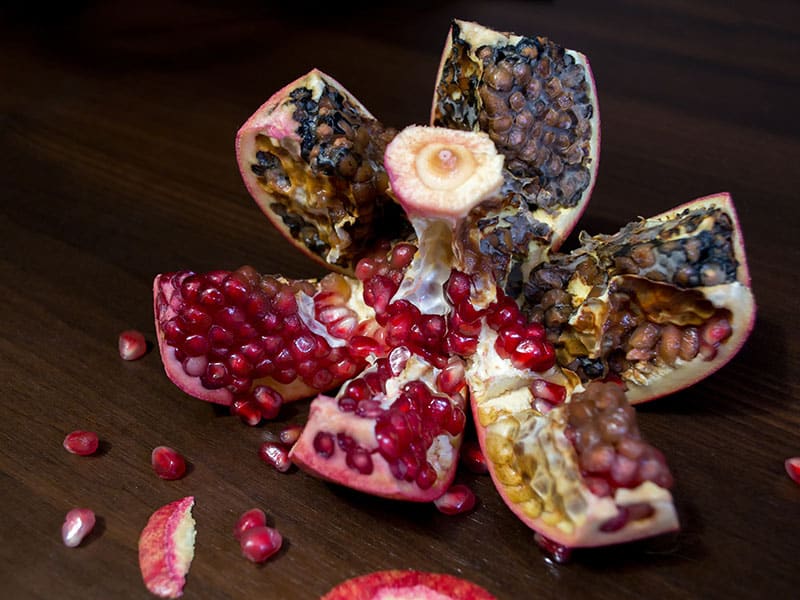
On your pomegranate adventure, you will surely come across some weird-tasting pomegranates. It’s possible that those pomegranates have gone bad and shouldn’t be eaten.
Watch out for these signs when buying and eating pomegranates!
- It Feels Light In Hand: A pomegranate contains hundreds of arils inside, so it’s practically impossible for the fruit to be light. If your pomegranate feels surprisingly light to hold, it’s probably spoiled.
- The Skin Feels Soft: Good pomegranates have thick, firm skins. If a large proportion of the skin is soft or mushy, the fruit has gone bad.
- There Are Dark, Mushy Spots: You might also see some dark spots on the skin. If there are only a few of them, you can cut it open and check. However, if there are too many black and sunken spots, there is no salvaging for that pomegranate.
- The Fruit Taste And Smell Rotten: Needless to say, if anything smells rotten, you should toss it away. The same thing applies to pomegranates.
- It Smells And Tastes Like Alcohol: In some cases, your pomegranate might have an alcohol-like smell and flavor. This is because the fruit has fermented for a while. To be safe, you should toss that pomegranate.
- Mold Or Black Spores: Do I even have to say anything about this? If you see these two things inside your pomegranate, you already know what to do.
- Brown Or Black Arils: Some varieties of pomegranates might have clear or pink arils, but I assure you, there’s none with black or brown arils. If the arils have turned into these two colors, you should never eat them.
How To Store Pomegranate
It’s important to always store your pomegranate properly. You don’t want these nutrition-packed superfruits to go to waste. Fortunately, pomegranates are quite simple to store.
| States | Storage time under ideal conditions |
| Unopened pomegranate wine | 3 years |
Whole, uncut pomegranates can be kept at room temperature for 1-2 weeks. If you decide to go this route, you should keep them somewhere dry, cool, well-ventilated, and away from sunlight.
If you put them in the fridge, they can last for 1-2 months. In the freezer, pomegranates will retain their best taste for 10-12 months. They’re still edible after that point but with a reduced quality.
Remember to wrap your pomegranates in plastic wrap before refrigerating or freezing for the best quality.
Pomegranate arils should always be stored in the fridge or in the freezer. In both cases, remember to put them into an airtight container first. They will last for about 1 week in the refrigerator and 6 months in the freezer.
Follow these 4 easy ways to keep your pomegranate for a long time.
You can also use the fridge and the freezer to store pomegranate juice.
When refrigerated, fully-sealed pomegranate juice will last about 1 week after the printed expiration day. You can keep it in the freezer for 8-12 months. Past the 12-month mark and the juice will start to lose taste but is still drinkable.
A bottle of opened pomegranate juice should be able to last for 7-10 days in the refrigerator after opening. If frozen, it will stay good for 8-12 months and remain safe to consume after that but won’t taste as good.
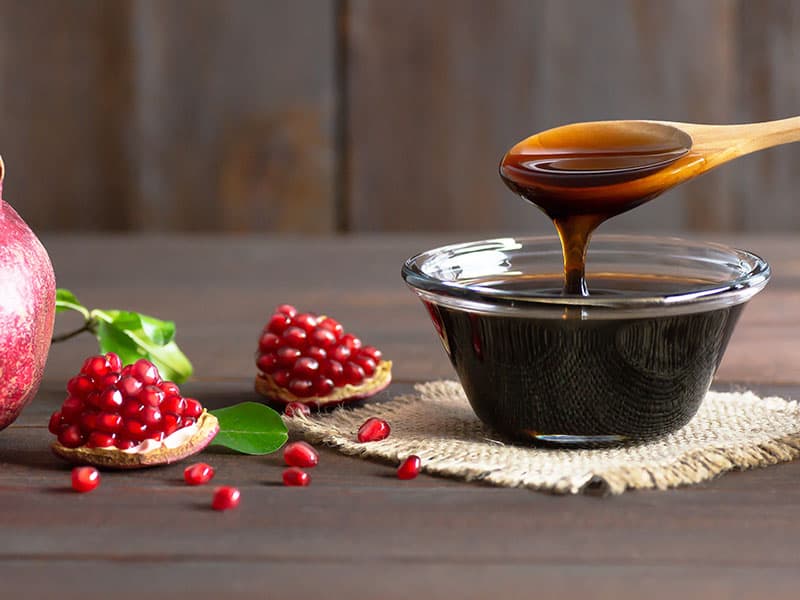
Pomegranate powder is quite simple to store and you don’t need to refrigerate them. Many manufacturers won’t give you an exact expiration date so as long as you keep the powder airsealed in a cool, dark, and dry place, it should last for 12 months.
Most molasses will come with a best-by date, some are only good for 1-2 years, others can last up to 4 years. Typically, you can store a bottle of unopened pomegranate molasses for about 1 year after the suggested usage date in a dark, dry, and cool spot of the pantry.
Even when opened, it will stay edible for about 6 months after the best-by date. It is not necessary to refrigerate store-bought pomegranate molasses. Do note that the quality will decrease over time.
Homemade pomegranate molasses, on the other hand, won’t last as long and will only keep for about 6 months in the fridge.
As a rule of thumb, always store wine horizontally in a dry, dark place at 45-65F and 70% humidity level. Unopened pomegranate wine, similar to other fruit wines, will generally last for 3 years this way.
You can also refrigerate the wine in a wine chiller if you have one (a regular fridge will also work). Pomegranate wine tastes the best when chilled so you’ll hit two birds with one stone by doing this.
Fruit wine won’t last for long when opened so you should enjoy your wine as soon as possible.
Turn Pomegranates Into Tasty Meals With These Recipes
While pomegranates taste good on their own, you can enhance the flavor further by integrating them into your cooking. Here are some great cooking ideas for pomegranates.
Pomegranates Feta Salad
The crunchiness and refreshing taste of pomegranates tie every ingredient together to create a whole bowl of colorful veggie deliciousness. In short, this vibrant-looking salad will brighten up your meal.
Pomegranate Marinade
Pomegranates can also be turned into a vegan, unique-tasting, and delicious marinade. If you’re looking for a way to elevate your pork, chicken, lamb, fish, or even beef, you can’t go wrong with this recipe.
Pomegranate Sorbet
Pomegranates already work great as a healthy and yummy dessert. That said, you can turn them into a more appealing one by making pomegranate sorbet. Now even the kids won’t have any excuse for not eating pomegranate!
With these 3 recipes, you’re ready to make a whole meal out of pomegranates. Try making them for your next dinner, and let me know the result in the comment below!
Tips To Deseed Pomegranate With Ease
Honestly speaking, pomegranate can be a pain in the neck to cut and deseed. I’ve struggled with this myself, so I can totally relate. That said, there’s an easy way to deseed pomegranate that you should know.
- Step 1: First, remember to cut off the crown first. This will make cutting into your pomegranate way simpler.
- Step 2: Then, slice the fruit into smaller parts. Do your best to avoid cutting into the arils. Instead, aim for white parts.
- Step 3: Don’t be too hasty to pry out the seeds immediately after cutting. You should soak them into a bowl of cool water for 5 minutes
- Step 4: After that, push the arils out carefully and drain them with a tea towel. Remember to let them dry entirely before storing them.
Another way to effectively deseed your pomegranates in just 1 minute!
FAQs
Many aren’t familiar with pomegranates, which means there are a lot of questions regarding this “exotic fruit”. These are the answers to some of the most commonly asked questions.
Stop Sleeping On Pomegranates!
Pomegranates are literally a gift from above with potent nutritional value and delicious taste. If you’ve been sleeping on this superfruit, you should start giving them some love. Trust me. It’s one of the best decisions that one can make!
If you’ve been a long-time fan of pomegranates like myself, let me know what you think about this fruit in the comments. Also, like and share this post for more content related to pomegranates and other tasty foods.
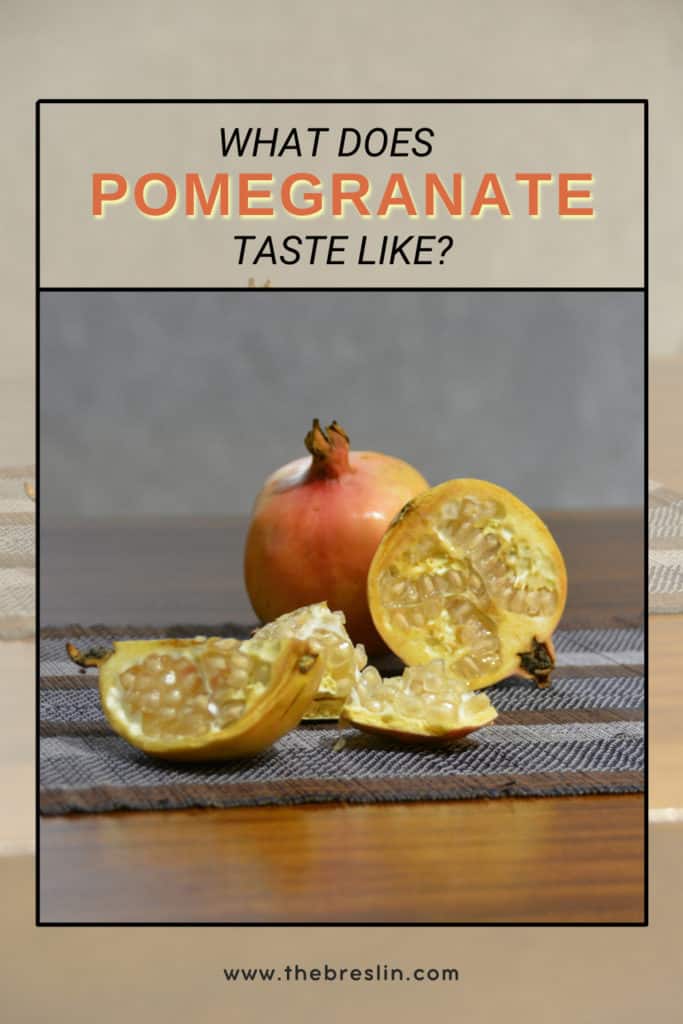
References
- Contributors to Wikimedia projects, (2002). Pomegranate – Wikipedia [online].
- MS, J. L., (2018). 12 Health Benefits of Pomegranate [online]. Healthline.
- Funk, A., (2018). America’s Pomegranates Are a Bore. One Researcher is Using His Grandfather’s Fruit to Change That


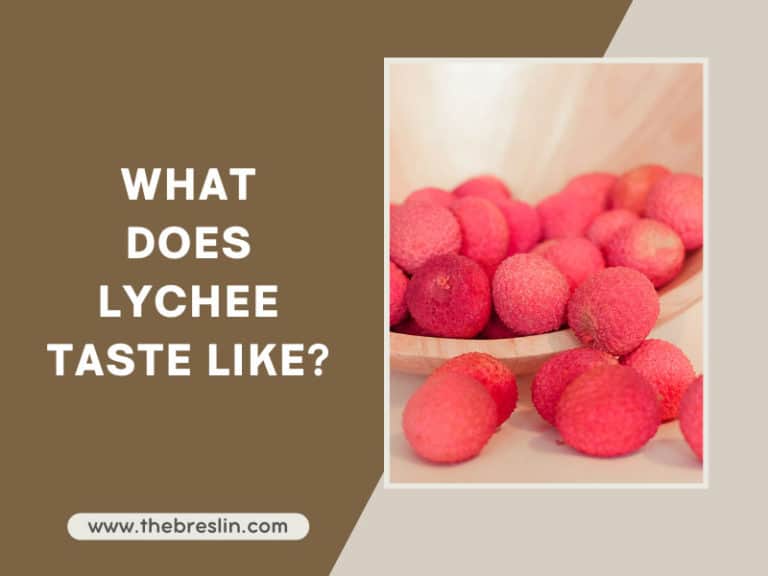

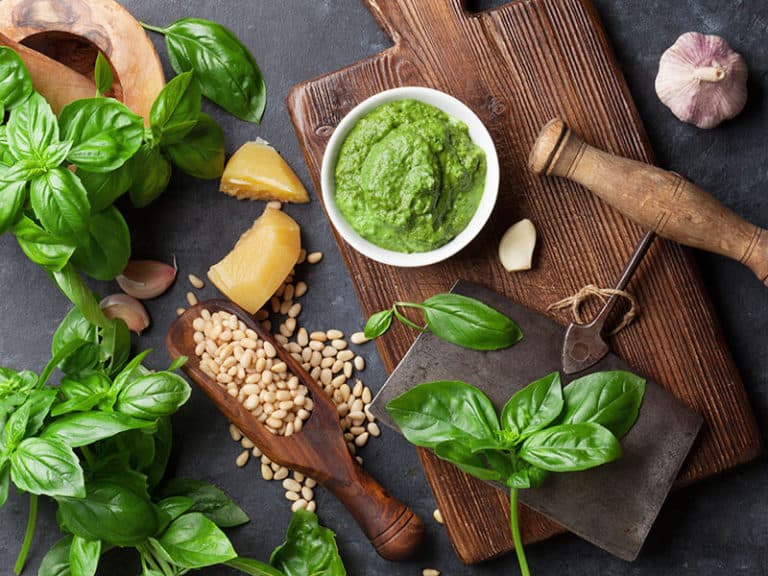


Amanda Collins
Founder and Senior Culinary Editor
Expertise
Culinary Arts and Management, Food Journalism and Critique, Recipe Development and Testing, Global Culinary Traditions, Sustainable Food Practices
Education
Institute of Culinary Education (ICE), New York, NY
Program: Diploma in Culinary Arts
Focus: Intensive hands-on training in culinary techniques, recipe development, and kitchen management, preparing students for professional roles in the culinary industry.
Monroe College, New Rochelle, NY
Program: Associate in Applied Science in Culinary Arts
Focus: Practical culinary skills, including cooking techniques, menu planning, and kitchen operations, with an emphasis on hands-on experience and industry standards.
Amanda Collins is a seasoned chef and food editor with a deep love for global flavors. Trained at the Institute of Culinary Education and Monroe College, and with over 15 years in the culinary field, Amanda has refined her skills in kitchens worldwide. Her background in food studies gives her a unique ability to share both recipes and the cultural stories that shape them.
As senior culinary editor at thebreslin.com, Amanda’s work brings authentic dishes to life, inviting readers to explore new flavors and techniques from around the globe. Her approachable style makes it easy for anyone to bring a bit of the world’s cuisine into their kitchen.